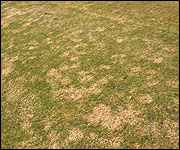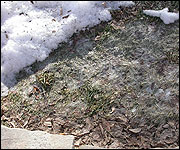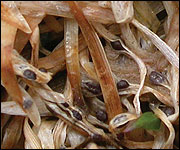Gray snow mold
Symptoms and signs | Conditions | Management
(Speckled snow mold)
Gray snow mold is a winter turfgrass disease in regions where snow cover persists for long periods. All grasses can be damaged to some extent, but injury is often more severe on annual bluegrass and bentgrass putting greens. Gray snow mold is uncommon in the lower Midwest.
Pathogen
- Typhula spp.
Hosts
- Most cool-season turfgrasses
Symptoms and signs
Gray snow mold begins to develop 30 to 45 days after permanent snow cover, but symptoms will not be apparent until after the snow has melted or has been removed.
Yellow to white circular patches of damaged turf are visible immediately following snow melt (Figure 1). These patches vary in size and may overlap to blight almost the entire turf stand (Figure 2). White to gray fungal mycelium may still be evident on diseased leaves, especially on higher cut turf, but will eventually dry out and disappear (Figure 3). As the damaged leaves begin to wither, the patches develop more of a white to gray color (Figure 4).
The observation of clamp connections at high magnification and sclerotia embedded in infected leaf tissue are diagnostic for gray snow mold. Clamp connections are "bridges" from one hyphal cell to another (Figure 5). The sclerotia are initially white to pink or orange, but harden and turn dark brown to black with age (Figure 6). The mature sclerotia range in size up to 0.2 inch in diameter.
Damage in home lawns and golf course fairways is often cosmetic. The turfgrass quickly recovers and resumes normal growth with the return of warm spring weather. However, damage to annual bluegrass and creeping bentgrass on putting greens and other closely mowed areas may be more extensive and spring recovery slower.
Conditions
Gray snow mold fungi are widely distributed in regions with long periods of snow cover. There are several species of Typhula, and their abundance in a particular location is governed in part by the length of snow cover. T. ishikariensis tends to be more prevalent in areas with long periods of snow cover, whereas T. incarnatais more common where snow cover periods are shorter.
These fungi persist through the summer as hardened sclerotia. In late fall, sclerotia germinate and begin to colonize the grass leaves. In some cases sclerotia may germinate to form fruiting structures (basidiocarps) that in turn produce spores (basidospores) that help disseminate the fungus and initiate disease.
The growth of Typhula spp. is favored by temperatures near freezing (32 to 36 degrees F). Thus, long periods of snow cover that help maintain temperatures at the soil surface just above freezing are ideal for fungal growth. The longer snow cover remains, the more extensive are the fungal colonization of the turfgrass and subsequent damage.
Management
The most consistent means of controlling gray snow mold is the use of preventive fungicide applications. Refer to Table 5 for a list of fungicides labeled for control of gray snow mold. Fungicides are rarely needed on home lawns because damage is normally superficial. In regions with a history of gray snow mold associated with extended periods of snow cover, preventive fungicide applications are required to maintain high turfgrass quality on golf courses and athletic fields.
Make a fungicide application in fall as close to permanent snow cover as possible. This helps prevent premature losses of the fungicide and maximizes chemical concentrations during the winter. Some turf managers also apply a gray snow mold preventive in late fall to help suppress germination of sclerotia and dispersal of spores.
The fungicide quintozene (PCNB) has been the standard snow mold fungicide for many years because of its persistence, efficacy and relatively low cost. However, PCNB may cause phytotoxicity to annual bluegrass and creeping bentgrass, especially on putting greens. Furthermore PCNB is losing its federal registration for use on turfgrasses.
Several other fungicides are used for management of gray snow mold. Generally a mixture of two or more fungicides with different modes of action is used for snow mold suppression. This increases efficacy against a range of snow mold pathogens.
Biological control agents, including isolates of T. phacorrhiza, have shown efficacy against gray snow mold; however, these have not yet been successfully developed into commercial products.
Excessive nitrogen fertilizer applications in the fall may increase gray snow mold severity. Use slow-release formulations of nitrogen if fall applications are needed. Continue mowing until winter dormancy to prevent excessive leaf growth and matting that may enhance fungal colonization.
There is a misconception that snow compaction caused by snowmobiles and skiers increases snow mold severity. In fact, compacting snow lowers temperatures at the soil/snow interface, often to temperatures below freezing, and inhibits snow mold development. Nevertheless there may be other problems associated with snow compaction, including slower spring green-up and freeze damage to subsurface irrigation lines.





